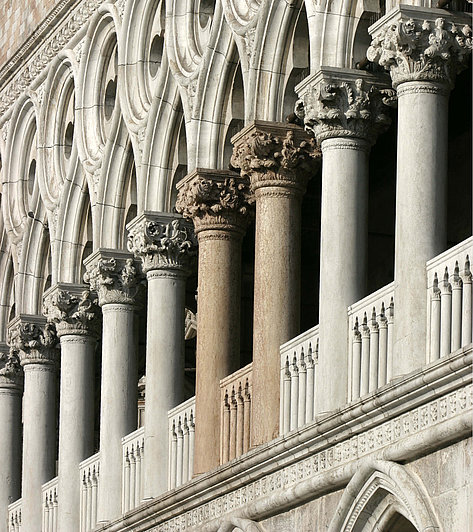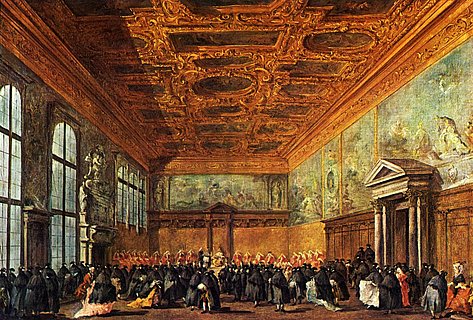Doge's Palace: Venice's center of power #veniceclassics
4 min readFrom the beginnings till now
In 811 the Doge Agnello Particiaco moved his seat of government to the "Rivo Alto", which, however, burned down in 976 together with St. Mark's Basilica due to a large fire. Also the successor building did not last for long, so that it was only under the 39th Doge Sebastiano Ziani that the first significant Doge's Palace was built at the end of the 12th century. The building consisted of three wings that housed the Doge's rooms, a Palace of Justice and a meeting hall, and at the same time included an inner courtyard. In addition, the building was made of stone instead of wood for the first time. From 1340, during the reign of Doge Bartolomeo Gradenigo, the palace was completely redesigned - this renovation shaped the current appearance of the Doge's Palace, because in this time the Byzantine style was replaced by the Gothic one. The construction of the "Porta della Carta" was the last construction project during this period and served as a representative entrance to the palace courtyard and as a connection to St. Mark's Basilica.
Further fires in the 15th and 16th century destroyed the palace again, but it was rebuilt and the facade restored according to the original plans. After the end of the Republic of Venice, the Doge's Palace was used as a seat for offices and institutions under French and Austrian rule - even today one of the offices is still located on the premises, the rest already moved to other locations. Since 1923 the city of Venice has been responsible for the administration of the Doge's Palace, which is open to the public as a museum.
Diverse and magnificent
Due to the many construction periods, the architecture of the Doge's Palace is a mixture of different styles and thus shows the change of time - whether oriental elements, Byzantine art, Gothic or Renaissance. The components of the complex lie on foundations made of tree trunks and Istrian stone and are made of bricks, covered with colorful marble. While the east side to the Rio del Palazzo consists of four floors, the south and west fronts are three stories high. The west side facing St. Mark's Square, which features a loggia with a portico on the first floor, was designed particularly elaborated and magnificent. Two of these pillars are colored in red - the death sentences have been announced to the people between them.
Fittingly there is a picture of the Justitia with a sword and scroll between two lions over a column nearby - a symbol of the case law, made by Filippo Calendarios. He was one of the most important architects and sculptors of the 14th century in Venice and was responsible, among other things, for one of the corner chapels on the upper floor, which shows the fall of man of Adam and Eve. The Porta della Carta, built by the Venetian architects Giovanni and Bartolomeo Bon, leads to the inner courtyard. The passage was not allowed for the Venetian citizens at the time, so they had to go through the "Porta della Frumento" to get to the Doge's Palace. The Porta della Carta was built in the late Gothic style with its richly decorated pointed arch windows and the many sculptures is a real trinket. The winged Lion of Saint Mark can also be found here, in front of which the Doge Francesco Foscari kneels in awe.
Great room for great deeds
Particularly the ceilings in the interiors are so sumptuously designed that when you enter, you do not know where to look first. The Doges were elected in the Great Council hall by around 1000 nobles. The hall is considered the largest unsupported room in Europe and with a length of 54 m also the largest one of the entire Doge's Palace. A huge picture entitled "Paradise" adorns the back wall of the room, which was painted by Jacopo Tintoretto. At that time, this impressive work of art was considered the largest painting in the world - today it is the second largest oil painting.
Accommodation for prisoners
The Doge's Palace not only offered space for meetings and official acts, but also housed prisoners of state and high treason. The prison is divided into two buildings that are connected by the Bridge of Sighs. And there were also prison cells in the Doge's Palace itself: the so-called "Pozzi" on the ground floor were connected by stairs to the office of the "Council of Ten" and equipped with doors and air ducts that only opened in the direction of the corridors. During floods, the cells, often equipped with stone block beds, were often flooded. Under the lead-covered roof of the palace 6 to 7 other cells were located, the "Piombi". The heat there was often unbearable, because the ventilation through a tiny window in the door hardly ensured air circulation. Mostly people who should be punished for political offenses or who were waiting for their judgment were accommodated here.
Giacomo Casanova
One of these prisoners was the notorious Giacomo Casanova (1725-1798), who managed to escape from the supposedly escape-proof "Piombi". He later wrote down his experiences and summarized them in the adventure novel “History of my Flight”. In there he also tells that when he escaped, he left the palace through one of the main entrances - he used the fine clothing he was wearing when arrested to camouflage him.








